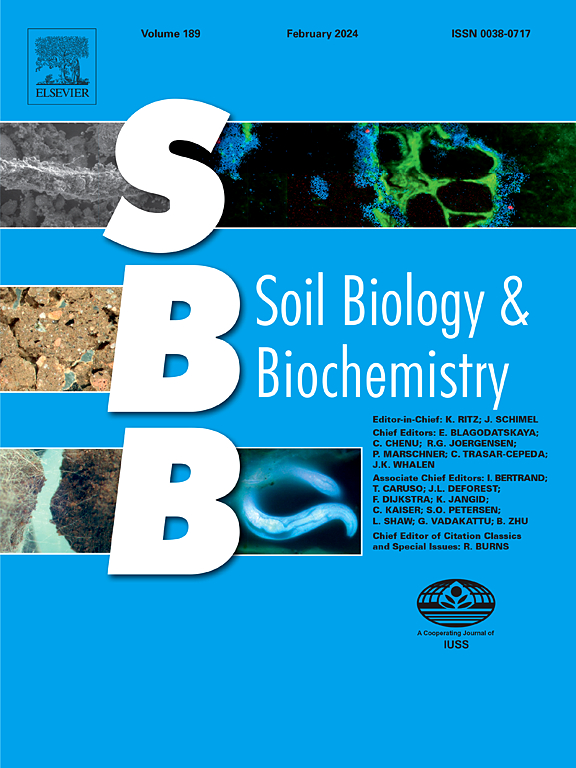支持土壤碳积累的种植系统中氮保持和N2O生产的微生物控制
IF 9.8
1区 农林科学
Q1 SOIL SCIENCE
引用次数: 0
摘要
硝酸盐的命运是提高种植系统氮利用效率的核心。它受到氨化器和反硝化器的影响,这是两个微生物行业,它们分别争夺硝酸盐并促进氮的保留和损失,后者以二氮气体和温室气体氧化亚氮(N2O)的形式存在。我们假设种植系统导致较高的土壤碳:硝酸盐有利于氨化,从而降低N2O排放并提高作物产量。我们在瑞典的三个气候区进行了长期的田间试验,比较了四种施肥制度下的年度谷物、秸秆还田和轮作。自试验建立以来,谷物轮作降低了土壤碳含量,而轮作对土壤碳的积极影响因粘土含量而异。然而,无论施肥制度如何,麦田轮作均显示出较低的硝酸盐水平,较低的N2O产量,以及与谷物种植相似或更高的谷物产量。16S rRNA基因测序结果显示,麦田轮作和谷物轮作土壤微生物组存在较大差异,并受施肥的影响。为了梳理对功能行业的影响,我们量化了氨化(nrfA),反硝化(nirK, nirS)和N2O还原(nosZI和nosZII)微生物群落的遗传潜力。硝态氮的有效性而不是碳含量解释了硝态氮在氨化器和反硝化器上的明显控制,较低的水平有利于前者。总之,我们的研究结果强调了整合碳氮管理策略在提高土壤碳含量的同时减少种植系统N2O排放的重要性。本文章由计算机程序翻译,如有差异,请以英文原文为准。
Microbial controls of nitrogen retention and N2O production in cropping systems supporting soil carbon accrual
The fate of nitrate is central for increasing nitrogen use efficiency in cropping systems. It is influenced by ammonifiers and denitrifiers, two microbial guilds that compete for nitrate and contribute to nitrogen retention and loss, respectively, with the latter in the form of dinitrogen gas and the greenhouse gas nitrous oxide (N2O). We hypothesized that cropping systems causing higher soil carbon:nitrate favor ammonifiers and thereby lower N2O emissions and improve crop yield. We sampled long-term field experiments comparing annual cereal, w/wo straw return, and ley rotations under four fertilization regimes replicated in three pedoclimatic zones in Sweden. Soil carbon content has decreased in the cereal rotations since the establishment of the experiments, whereas positive effects of leys on soil carbon varied depending on clay content. Nevertheless, the ley rotations displayed consistently lower nitrate levels irrespective of fertilization regime, lower N2O production rates, and similar or higher cereal yields compared to cereal cropping. Sequencing of 16S rRNA genes showed major differences in the soil microbiome between ley and cereal rotations, with some effects of fertilization. To tease apart effects on the functional guilds, we quantified the genetic potential of ammonifying (nrfA), denitrifying (nirK, nirS) and N2O reducing (nosZI and nosZII) microbial communities. Nitrate availability rather than carbon content explained the apparent control of carbon:nitrate on ammonifiers vs denitrifiers, with lower levels favoring the former. Altogether, our findings highlight the importance of integrating carbon and nitrogen management strategies to improve soil carbon content while also reducing N2O emissions from cropping systems.
求助全文
通过发布文献求助,成功后即可免费获取论文全文。
去求助
来源期刊

Soil Biology & Biochemistry
农林科学-土壤科学
CiteScore
16.90
自引率
9.30%
发文量
312
审稿时长
49 days
期刊介绍:
Soil Biology & Biochemistry publishes original research articles of international significance focusing on biological processes in soil and their applications to soil and environmental quality. Major topics include the ecology and biochemical processes of soil organisms, their effects on the environment, and interactions with plants. The journal also welcomes state-of-the-art reviews and discussions on contemporary research in soil biology and biochemistry.
 求助内容:
求助内容: 应助结果提醒方式:
应助结果提醒方式:


